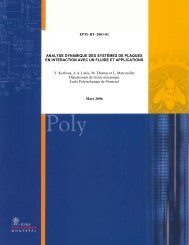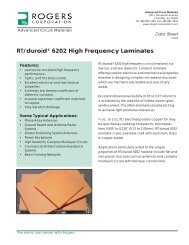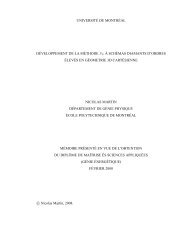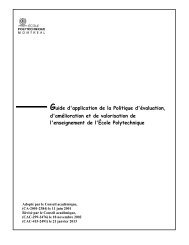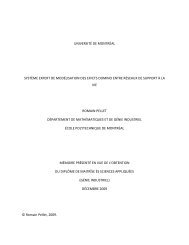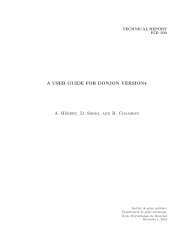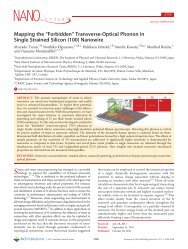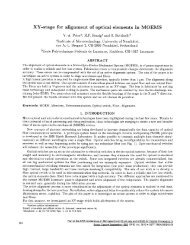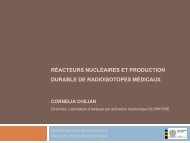new photoresist coating method for high topography surfaces
new photoresist coating method for high topography surfaces
new photoresist coating method for high topography surfaces
You also want an ePaper? Increase the reach of your titles
YUMPU automatically turns print PDFs into web optimized ePapers that Google loves.
NEW PHOTORESIST COATING METHOD<br />
FOR HIGH TOPOGRAPHY SURFACES<br />
Kazem Zandi 1 , Ying Zhao 2 , Juan Schneider 2 , and Yves-Alain Peter 1<br />
1 Ecole Polytechnique de Montréal, Montréal, Canada<br />
2 Nanometrix Inc., Montréal, Canada<br />
ABSTRACT<br />
A novel technique of <strong>photoresist</strong> <strong>coating</strong>, Dynamic<br />
Surface Tension (DST) <strong>coating</strong>, is presented. This<br />
technique is particularly well suited <strong>for</strong> <strong>surfaces</strong> with<br />
pre-existing <strong>topography</strong>, which is often the case in<br />
micro-electro-mechanical systems (MEMS) and<br />
integrated circuits packaging. A simple setup is<br />
employed and several resist solutions are tested.<br />
Promising results are obtained using a commercial<br />
<strong>photoresist</strong> Shipley SPR 220-3.0. Uni<strong>for</strong>m coverage<br />
on micromachined <strong>surfaces</strong> with <strong>high</strong> <strong>topography</strong> is<br />
demonstrated. Successful pattern transfer at the<br />
bottom and on top of silicon trenches as deep as<br />
15!m with different width from 1!m to 100!m was<br />
achieved with 1.5!m resolution.<br />
INTRODUCTION<br />
With the development of MEMS and the growing use<br />
of three dimensional microstructures, <strong>new</strong> techniques<br />
are required to fulfill the demand <strong>for</strong> uni<strong>for</strong>m<br />
<strong>photoresist</strong> coverage over non-planar <strong>surfaces</strong> with<br />
<strong>high</strong> <strong>topography</strong>, like trenches, V-grooves, and<br />
cavities. Thus, the con<strong>for</strong>mal <strong>photoresist</strong> <strong>coating</strong> of<br />
wafers with 3D microstructures becomes a critical<br />
step in the integration process. In the MEMS<br />
fabrication process of devices, there are three main<br />
different <strong>photoresist</strong> <strong>coating</strong> techniques: spin <strong>coating</strong>,<br />
electrodeposition (ED) <strong>coating</strong>, and spray <strong>coating</strong> [1-<br />
5]. Several ef<strong>for</strong>ts to obtain a con<strong>for</strong>mal <strong>coating</strong> layer<br />
by using spin <strong>coating</strong> have been reported [1, 2].<br />
Although spin <strong>coating</strong> is an established technique <strong>for</strong><br />
resist deposition, it is often not suitable <strong>for</strong><br />
applications with <strong>high</strong> <strong>topography</strong> on silicon or glass<br />
surface because of defects generated in the resist<br />
layer during the process. More specifically, the<br />
<strong>photoresist</strong> flows down along the sidewalls of<br />
trenches due to gravity, gathers at the bottom corners,<br />
and is detached at the top corners, as shown in Fig.1.<br />
This figure shows an array of trenches, that were<br />
created in silicon by using deep reactive ion etching<br />
(DRIE) process, and were further coated with<br />
commercial <strong>photoresist</strong> shipley SPR 220-3.0 using<br />
spin <strong>coating</strong> <strong>method</strong>. Electrodeposition of <strong>photoresist</strong><br />
has been reported as a useful <strong>method</strong> <strong>for</strong> 3-D stacks<br />
of chips [3] but it requires a conductive layer. As a<br />
result, electroplating of <strong>photoresist</strong> is restricted to the<br />
backend processing. In the case of spray <strong>coating</strong>, no<br />
commercial <strong>photoresist</strong> exist that could be used<br />
without being diluted. Also the diluted <strong>photoresist</strong> is<br />
thick (9!m) not allowing to get a good resolution, the<br />
thickness of <strong>photoresist</strong> is not uni<strong>for</strong>m and depends<br />
on the geometry. For instance, if <strong>coating</strong> an array of<br />
cavities, only those cavities having the same size<br />
would be covered with the same thickness of<br />
<strong>photoresist</strong> [3]. Here we report a novel technique<br />
using a commercial <strong>photoresist</strong> (Shipley SPR 220-<br />
3.0) to achieve uni<strong>for</strong>m <strong>photoresist</strong> coverage not only<br />
on planar <strong>surfaces</strong>, but also on a micromachined<br />
surface with <strong>high</strong> <strong>topography</strong>. Photoresist has the<br />
same thickness (1.5!m) everywhere independent of<br />
the geometry of the patterned surface. Table 1 shows<br />
a comparison of this <strong>new</strong> technique with the three<br />
other existing ones.<br />
Fig. 1. An array of trenches with resist coated by<br />
spinning <strong>method</strong>.<br />
DYNAMIC SURFACE TENSION<br />
COATING<br />
Dynamic surface tension process<br />
Consider a solution (here polymer) poured on the<br />
surface of a liquid that has a greater surface tension<br />
(called carrier liquid) in the presence of a gas. At the<br />
triple contact point P (Fig. 2), which is the junction of<br />
gas, carrier liquid and solution, interfacial <strong>for</strong>ces pull<br />
the dispensed solution to spread out, covering the<br />
entire region of the carrier liquid that is exposed to<br />
the gas phase [6].<br />
978-1-4244-5763-2/10/$26.00 ©2010 IEEE 392
Table 1 A comparison between DST technique and three others techniques.<br />
SPIN COATING ED COATING SPRAY COATING DST COATING<br />
Process Simple<br />
Geometry dependent<br />
Complicated Simple<br />
Geometry dependent<br />
Simple<br />
Geometry independent<br />
Substrate Conductor or Insulator Only conductor Conductor or Conductor or Insulator<br />
material<br />
Insulator<br />
Photoresist Commercial Specific<br />
ED resist<br />
Not commercial<br />
8!m resolution<br />
Commercial<br />
1.5 !m resolution<br />
Resist<br />
uni<strong>for</strong>mity<br />
Not uni<strong>for</strong>m on preexisting<br />
<strong>topography</strong><br />
Uni<strong>for</strong>m Depends on geometry Uni<strong>for</strong>m<br />
Gas phase<br />
Polymer<br />
Carrier liquid<br />
F ! 1<br />
F ! P<br />
3<br />
F ! 2 ! ! ! !<br />
F # F1 " F2<br />
" F3<br />
Fig. 2. The driving <strong>for</strong>ce F !<br />
<strong>for</strong> spreading comes<br />
from the resultant of 3 surface tension vectors at the<br />
interface of 3 different media.<br />
Let’s define F 1 as the surface tension between the gas<br />
phase and the solution, F 2 the surface tension<br />
between the solution and the carrier liquid, and F 3 the<br />
surface tension between the gas phase and the liquid<br />
carrier. At the moment of the injection, the presence<br />
of solvent (polymer) makes F 1 and F 2 to decrease,<br />
making F 3 greater than the sum of the two others,<br />
driving the solution to expand so as to cover the<br />
maximum surface possible. The spreading dynamics<br />
is described by the vector equation (1):<br />
F = F 3 – (F 1 + F 2 ) (1)<br />
If [F] x > 0, where [F] x is the scalar of F in the<br />
direction of the x axis, parallel to the horizontal gasliquid<br />
interface, the solution will spread out over the<br />
entire free surface of the carrier liquid until [F] x<br />
reaches zero or becomes negative due to solvent<br />
evaporation / miscibility affecting the concentration<br />
and viscosity of the material cast during the<br />
spreading. Over time, the solvent dissipates, which<br />
causes F 1 and F 2 to increase. As a consequence, the<br />
illustrated droplet will reach an equilibrium point and<br />
beyond, stopping the spreading phenomena. By<br />
controlling the interaction between these interfacial<br />
tensions, it is thus possible to control the thickness of<br />
the film. While the polymer thins down due to<br />
solvent evaporation or immersion (dilution of the<br />
solvent in the liquid), the quasi gel-solidified polymer<br />
film is transferred at a predetermined rate to a<br />
substrate <strong>for</strong>ming part or carried by the transferring<br />
unit. The thickness of the thin film or layer is<br />
generally governed mainly by 1) the concentration<br />
(the relative content of solvent and polymer in the<br />
injected solution), 2) the rate of injection, and 3) the<br />
dynamics of evaporation and/or miscibility of solvent<br />
in the carrying liquid.<br />
EXPERIMENTAL SETUP<br />
The deposition is realized by pouring <strong>photoresist</strong> on<br />
the surface of carrier liquid in the presence of air.<br />
Photoresist solution is injected from an injection unit<br />
while the carrying liquid and the gas phase (air) are<br />
controlled <strong>for</strong> proper conditions. Figure 3 shows the<br />
DST process that takes place inside a cartridge at the<br />
gas-liquid interface. Polymer spreading is driven by<br />
the surface tension differential. The solidifying<br />
polymer is continuously taken from the cartridge to<br />
the substrate that we want to coat. The substrate is<br />
placed on a movable handle called wafer handling<br />
unit (WHU). Transfer is guaranteed by the presence<br />
of the capillary bridge between the cartridge and the<br />
substrate.<br />
Key parameters that influence the thickness,<br />
uni<strong>for</strong>mity and quality of the <strong>photoresist</strong> layer are:<br />
- Solid content of the solution<br />
- Solvent evaporation rate and miscibility<br />
- Temperature<br />
- Gas pressure<br />
- Speed of WHU<br />
- Injection rate of the solution<br />
The first two parameters are related to the resist<br />
solution while the other four are related to the DST<br />
setup. The first three parameters control viscosity of<br />
the polymer and spreading factor at P junction. In<br />
other words affect on driving <strong>for</strong>ce F (Fig. 2). During<br />
the process, vapour of solvent content changes the<br />
gas pressure and modifies the smoothness of the<br />
coated layer. There<strong>for</strong>e a good control has to be<br />
accomplished during the process of <strong>coating</strong>. For<br />
proper and uni<strong>for</strong>m <strong>coating</strong>, the WHU needs to have<br />
the same speed as spreading process. Also a dynamic<br />
balance between the solution injection rate and thin<br />
film <strong>coating</strong> rate is required.<br />
393
a) b)<br />
Fig. 4. a) Coated AZ9260 resist diluted with butyl<br />
alcohol (solid content of 17%), b) zoom on one<br />
trench.<br />
Photoresist type<br />
Fig. 3. DST setup.<br />
Most conventional <strong>photoresist</strong>s cannot be used<br />
directly <strong>for</strong> DST <strong>coating</strong> because of their <strong>high</strong><br />
viscosity. There<strong>for</strong>e they have to be diluted with<br />
solvents in order to lower their viscosity. Basically<br />
the DST <strong>coating</strong> system can be operated using<br />
solutions with viscosity lower than 470 cP. Using too<br />
viscose <strong>photoresist</strong>s cause small driving <strong>for</strong>ce and<br />
there<strong>for</strong>e create non uni<strong>for</strong>m layer. Several<br />
<strong>photoresist</strong> solutions have been investigated in order<br />
to find the most appropriate one <strong>for</strong> the purpose of<br />
<strong>coating</strong> <strong>high</strong> <strong>topography</strong> <strong>surfaces</strong>.<br />
We have investigated AZ9260 resist solutions that<br />
are diluted from the original <strong>photoresist</strong> by adding<br />
solvents. Also SPR 220-3.0 resist was used without<br />
dilution.<br />
EXPERIMENTS AND RESULTS<br />
Several silicon samples containing an array of<br />
trenches with different widths etched by DRIE, are<br />
prepared <strong>for</strong> the DST <strong>coating</strong> experiments. We used<br />
water as the carrier liquid and air as the gas in the<br />
experiments. Unlike the other <strong>method</strong>s of <strong>coating</strong>, in<br />
DST <strong>coating</strong>, <strong>photoresist</strong> is coated on top (stacked) of<br />
the trenches making it interesting and useful <strong>for</strong> some<br />
special application where fabricating a cavity inside<br />
the structure is desired.<br />
Figure 4 shows SEM pictures of a sample coated<br />
with AZ9260 resist using DST <strong>method</strong>. We used<br />
butyl alcohol as solvent with a solid content of 17%.<br />
The speed <strong>for</strong> WHU was 8 mm/s. As seen in Fig. 4,<br />
the <strong>coating</strong> is not uni<strong>for</strong>m. The thickness of<br />
<strong>photoresist</strong> at the top of steps are 4!m whereas at the<br />
corners is almost zero, meaning the deposited film is<br />
not planar. For <strong>surfaces</strong> with <strong>topography</strong>, the extent<br />
of planarization is defined as [7]:<br />
%Planarization = (H-h)/H,<br />
where H and h are the depth (or height) of the<br />
<strong>topography</strong> on the uncoated and coated surface,<br />
respectively, as shown in Fig. 5.<br />
The degree of planarization increases with decreasing<br />
distance between trenches (or steps) and with<br />
increasing film thickness (<strong>high</strong> viscosity <strong>photoresist</strong>)<br />
when spin <strong>coating</strong> <strong>method</strong> is used [8]. In DST<br />
<strong>method</strong>, planarization is independent of trench (or<br />
steps) height which is a great advantage over other<br />
Fig. 5. Schematic of the coated film profile.<br />
<strong>method</strong>s. Instead, planarization is proportional to h´/h<br />
where h´ is the thickness of <strong>photoresist</strong> at the corner<br />
of steps. As the coated film flow deeper, h increases<br />
and there<strong>for</strong>e the thickness at the corner of steps<br />
decreases, leading to poorer planarization. As seen in<br />
Fig. 4, the thickness at the corners is almost zero<br />
meaning zero planarization. Figure 6 shows a more<br />
uni<strong>for</strong>m <strong>coating</strong> realized with AZ9260 <strong>photoresist</strong><br />
diluted in acetone with a solids content of 33%. The<br />
speed <strong>for</strong> WHU was 8 mm/s.<br />
a)<br />
h<br />
Fig. 6. a) Coated AZ9260 resist diluted with acetone<br />
(solids content of 33%), b) zoom on one trench.<br />
The thickness of <strong>photoresist</strong> is 4.7!m at the top of<br />
steps and is 1.8!m at the corners, providing 38%<br />
planarization. Fig. 7 shows another sample coated<br />
with AZ9260 <strong>photoresist</strong> diluted in acetone with a<br />
solids content of 17%. The speed <strong>for</strong> WHU was 12<br />
mm/s. The thickness of <strong>photoresist</strong> is 1.6!m at the<br />
top of steps and is 0.7!m at the corners, providing a<br />
better planarization of 44%.<br />
b)<br />
h´<br />
H<br />
394
Figure 10 shows the sample after stripping the<br />
<strong>photoresist</strong>. The edges of the trenches are sharp<br />
demonstrating the uni<strong>for</strong>mity of the <strong>coating</strong>.<br />
a)<br />
b)<br />
Edges of trenches after second etching<br />
Fig. 7. a) Coated AZ9260 resist diluted with acetone<br />
(solids content of 17%), b) zoom on one trench.<br />
Another sample was coated with SPR 220-3.0<br />
<strong>photoresist</strong>. Since this type of <strong>photoresist</strong> has low<br />
viscosity, we did not dilute it with any solvents. The<br />
speed <strong>for</strong> WHU was 12 mm/s. The resulting coated<br />
profile is shown in Fig. 8. The coated <strong>photoresist</strong> on<br />
top of the trenches is uni<strong>for</strong>m and has the same<br />
thickness as that at the corners, providing optimal<br />
planarization. The thickness of <strong>photoresist</strong> is 1.5 !m<br />
everywhere and is independent of trench (or cavity)<br />
geometry. Since the coated <strong>photoresist</strong> is thin,<br />
lithography with <strong>high</strong> precision (1.5 !m) is feasible.<br />
Figure 9 shows the same sample after<br />
photolithography and etching. The bottom of trenches<br />
and the top of steps have been perfectly etched while<br />
preserving the masked areas.<br />
Fig. 10. Sample after stripping the <strong>photoresist</strong>.<br />
CONCLUSION<br />
In conclusion we have successfully coated uni<strong>for</strong>mly<br />
a commercial <strong>photoresist</strong> on a surface with <strong>high</strong><br />
<strong>topography</strong> by utilizing a novel technique. The resist<br />
uni<strong>for</strong>mity is independent on position and size of the<br />
trenches (or cavity) and a 1.5 !m photolithography<br />
resolution was achieved.<br />
REFERENCES<br />
Fig. 8. Coated SPR 220-3.0 resist.<br />
Photoresist<br />
Etched<br />
trench<br />
Open windows in<br />
<strong>photoresist</strong><br />
Etched<br />
trenches<br />
Fig. 9. Etched sample after photolithography and<br />
DRIE.<br />
[1] N. P. Pham et al., “IC-compatible process <strong>for</strong><br />
pattern transfer in deep wells <strong>for</strong> integration of RF<br />
components”, Proc. SPIE conf. vol.4174, pp.390-397,<br />
2000.<br />
[2] V. G. Kutchoukov et al., “New <strong>photoresist</strong><br />
<strong>coating</strong> <strong>method</strong> <strong>for</strong> 3-D structured wafers”, Sensor &<br />
Actuator A, vol. 85, pp. 377-383, 2000.<br />
[3] N. P. Pham et al., “Spray <strong>coating</strong> of <strong>photoresist</strong><br />
<strong>for</strong> pattern transfer on <strong>high</strong> <strong>topography</strong> <strong>surfaces</strong>”, J.<br />
Micromech. Microeng., vol.15, pp. 691- 697, 2005.<br />
[4] L. Yu, Y.Y. Lee, F.E.H. Tay, C. Iliescu, “Spray<br />
<strong>coating</strong> of <strong>photoresist</strong> <strong>for</strong> 3D microstructures with<br />
different geometries”, J. Phys. Conf. Ser., vol. 34, pp.<br />
937–942, 2006.<br />
[5] K. Fisher and R. Suss, “Spray <strong>coating</strong>-a solution<br />
<strong>for</strong> resist film deposition across severe <strong>topography</strong>”,<br />
IEEE/SEMI Int. Elec. Manuf. Tech. Symp. pp 338-<br />
41, 2004.<br />
[6] J. Schneider, US Patent 2009/0181162 A1, July<br />
16, 2009.<br />
[7] S.A. Gupta, and R.K.Gupta, “A parametric study<br />
of spin <strong>coating</strong> over <strong>topography</strong>”, Industrial and<br />
Engineering Chemistry Research, vol. 37, pp. 2223–<br />
2227, 1998.<br />
[8] L. K. White, “Planarization properties of resist<br />
and polyimide Coatings”, J. Electrochem. Soc., vol.<br />
130, pp. 1543-1548, 1983.<br />
395



